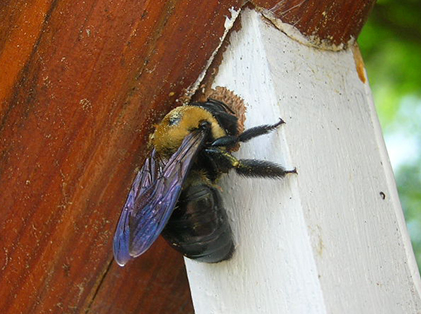Carpenter Bees
go.ncsu.edu/readext?798926
en Español / em Português
El inglés es el idioma de control de esta página. En la medida en que haya algún conflicto entre la traducción al inglés y la traducción, el inglés prevalece.
Al hacer clic en el enlace de traducción se activa un servicio de traducción gratuito para convertir la página al español. Al igual que con cualquier traducción por Internet, la conversión no es sensible al contexto y puede que no traduzca el texto en su significado original. NC State Extension no garantiza la exactitud del texto traducido. Por favor, tenga en cuenta que algunas aplicaciones y/o servicios pueden no funcionar como se espera cuando se traducen.
Português
Inglês é o idioma de controle desta página. Na medida que haja algum conflito entre o texto original em Inglês e a tradução, o Inglês prevalece.
Ao clicar no link de tradução, um serviço gratuito de tradução será ativado para converter a página para o Português. Como em qualquer tradução pela internet, a conversão não é sensivel ao contexto e pode não ocorrer a tradução para o significado orginal. O serviço de Extensão da Carolina do Norte (NC State Extension) não garante a exatidão do texto traduzido. Por favor, observe que algumas funções ou serviços podem não funcionar como esperado após a tradução.
English
English is the controlling language of this page. To the extent there is any conflict between the English text and the translation, English controls.
Clicking on the translation link activates a free translation service to convert the page to Spanish. As with any Internet translation, the conversion is not context-sensitive and may not translate the text to its original meaning. NC State Extension does not guarantee the accuracy of the translated text. Please note that some applications and/or services may not function as expected when translated.
Collapse ▲Carpenter bees are easy to confuse with bumblebees. Behavior and appearance are two characteristics that can be used to tell them apart.
Carpenter bees have a shiny, iridescent, hairless abdomen that may reflect blue, blue-black, purple, green, or bronze colors. Bumblebees are not shiny at all and may in fact look furry because they are covered all over with hair.
Male carpenter bees have a dramatic, zigzag flight and aggressively defend their territory. They are very noisy when they fly, wings humming or hovering and they may even seem to threaten humans. It’s like the dog that is all bark and no bite: the male carpenter bee cannot sting, only intimidate! Female carpenter bees usually concentrate on stocking the nest with food, but can sting quite badly if they are handled. In contrast, bumblebees do not hover for long periods, they seem relatively cautious around humans, and keep busy foraging for pollen and nectar.
 In nature carpenter bees nest in dead, but sound parts of living trees. However, many homes and decks are built of rough, unfinished wood that serves the same purpose as a tree. I have seen carpenter bees nesting in split rail fences, and roof overhangs seem to be a favorite spot, too. The female carpenter bee bores a perfectly round 3/8 – ½” diameter entrance hole, then turns at a right angle and makes a tunnel several inches long. They do not feed on the wood, they only use the tunnel to raise their young, so you may see the sawdust that is pushed out of the hole. The female lays her eggs in the tunnel and then places pollen and nectar in the nest for the grubs to eat after they hatch. One female can make several nest tunnels in one season.
In nature carpenter bees nest in dead, but sound parts of living trees. However, many homes and decks are built of rough, unfinished wood that serves the same purpose as a tree. I have seen carpenter bees nesting in split rail fences, and roof overhangs seem to be a favorite spot, too. The female carpenter bee bores a perfectly round 3/8 – ½” diameter entrance hole, then turns at a right angle and makes a tunnel several inches long. They do not feed on the wood, they only use the tunnel to raise their young, so you may see the sawdust that is pushed out of the hole. The female lays her eggs in the tunnel and then places pollen and nectar in the nest for the grubs to eat after they hatch. One female can make several nest tunnels in one season.
The damage done by carpenter bees is usually only cosmetic in nature. And these insects are good pollinators, so if you can tolerate a little damage that is best. Woodpeckers can cause serious damage by destroying sections of wood with a nest in it looking for grubs. Smooth, painted, finished structures are usually not attractive to carpenter bees so you can prevent damage by applying heavy coats of paint or varnish to wood.




